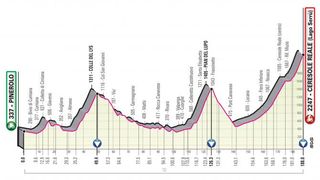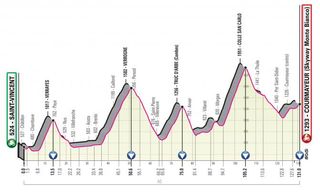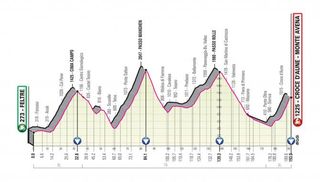Giro d'Italia 2019: 5 key stages
Gavia and Mortirolo return, while Croce d'Aune features in grand finale





Following the presentation of the 2019 Giro d'Italia route in Milan on Wednesday, you can be certain that those top-name riders who already know they're likely to be taking part next May will be scurrying to reconnoitre some of the key climbs and stages on which they're hoping to be able to distance their rivals.
We detail five of the most important stages of a race that seemingly has it all, from the fast and flat opening week for the sprinters to the five summit finishes that come in the latter half of the race, with all of that punctuated by three individual time trial stages, totalling 58.5 kilometres against the clock: the opening stage in Bologna, stage 9 from Riccione to San Marino, and the final stage in Verona.
Race director Mauro Vegni has hinted that those riders lining up in Bologna on May 11 could include Bahrain Merida's Vincenzo Nibali – Giro winner in 2013 and 2016 – and UAE Team Emirates' Fabio Aru, who finished second at the race in 2015, and third in 2014.
Other possible starters include Team Sky's Chris Froome – the defending Giro champion – and teammate Geraint Thomas, who's talked about his "unfinished business" at the race, which was the 2018 Tour de France winner's main objective back in 2017, until a crash saw him forced to retire with a shoulder and knee injury in the second week.
Thomas and Froome would both start the 2019 Giro as firm favourites, as the relatively high number of time trial kilometres across three stages would suit them down to the ground, and possibly turn the 2019 Giro into a two-horse race – especially if 2017 Giro champion Tom Dumoulin chooses not to return to the race that he also finished second at last year.
Dumoulin and his Sunweb team suggested last month that two Grand Tours in 2018 had been a stretch for the Dutchman, and that despite also taking second place to Thomas at the Tour de France last year, the 27-year-old may go all in on the hunt for Tour victory in 2019, to the detriment of the Giro.
Either way, and whoever's there, the corsa rosa is a play bigger than its actors, and its route is arguably the biggest star.
Get The Leadout Newsletter
The latest race content, interviews, features, reviews and expert buying guides, direct to your inbox!
Stage 9: Riccione to San Marino, 34.7km ITT (May 19)
After hosting the Grande Partenza in Bologna the previous week, the Emilia-Romagna region welcomes the Giro back for stage 9. Like the opening stage, it will be another individual time trial that finishes on a climb, but this time the riders face 34.7km, starting in the seaside resort of Riccione, on the Adriatic coast, near Rimini, and climbing to San Marino.
Once they reach Faetano, after 22 kilometres, they'll know all about it, as the road begins its rise – over 12.2km, with an average gradient of 4.5%, and a maximum of 11% – towards a denouement 648 metres above sea level in San Marino, which has in the past welcomed Giro time trial winners in the shape of Charly Gaul, Eddy Merckx, Felice Gimondi and Pavel Tonkov.
The stage is held over a very similar route to the time trial held at the 1987 race, between Rimini and San Marino, when Roberto Visentini won the stage and took the pink leader's jersey from the shoulders of his Carrera teammate Stephen Roche, while the last Giro stage to finish in San Marino was in 1998, when Andrea Noè beat the late Marco Pantani for the victory.

Stage 13: Pinerolo to Ceresole Reale (Lago Serrù), 188km (May 24)
Fans – and less so many of the riders – will have been waiting for the 2019 Giro's first road stage with a summit finish, and it appears in the shape of the 188km stage 13 from Pinerolo to Lago Serrù, close to the town of Ceresole Reale.
The spectacular Serrù lake is just a stone's throw from the French border, and the Giro peloton faces a 20.3km climb up to the finish there, on a road that reaches maximum gradients of 14%, averaging 5.9%, and one which is being used by the race for the very first time.
The climb is also known as the Colle delle Nivolet – a name serious film buffs may recognise as the road climb used to shoot several scenes in the Michael Caine movie The Italian Job, including that iconic – no spoiler – teetering bus moment.
The riders will already have had to tackle two climbs in the shape of the Colle del Lys early on in the stage, on the outskirts of Turin, followed by the short – 9.4km – but sharp Pian del Lupo, which averages 8.7% and, like the final climb to come after it, reaches a maximum gradient of 14%.
We may be only two weeks into the race by this point, but an Oscar-worthy performance on the Colle delle Nivolet by any one of the main contenders could prove to be a killer blow.

Stage 14: Saint Vincent to Courmayeur, 131km (May 25)
If you were looking for the most shark-tooth-profile-esque stage at the 2019 Giro, then stage 14 between Saint Vincent and Courmayeur is it.
Four climbs, and the uphill finish to the Skyway Monte Bianco cable car station, are packed into 131 kilometres, which is a lot further than the 2018 Tour de France's 65km-long and action-packed stage 17, but is on the shorter side by the Giro's standards, and could see plenty of movement by the overall contenders.
The riders take on the relatively minor climb of Verrayes soon after the start in Saint-Vincent, followed by the 14km-long Verrogne and the Truc d'Arbe.
The Colle San Carlo is a vicious climb that averages just under 10% over 10.5km, and includes a section at 15%. It's been used regularly by the Giro della Valle d'Aosta stage race, and has appeared four times on the Giro d'Italia route.
It was here at the 2006 Giro that Leonardo Piepoli was first across the summit before screaming a short way down the other side to the town of La Thuile to take the stage victory ahead of Ivan Basso.
This time, the race passes through La Thuile on its way down the San Carlo before the route rises again for the finishing climb to the Courmayeur ski resort.
Courmayeur had helped decide the outcome of the 1959 Giro, when Charly Gaul won there and took the pink jersey from Jacques Anquetil. Gaul had held the race lead for much of the first half of that Giro, but it had been taken from him by Jacques Anquetil in Verona on stage 13.
The stage to Courmayeur was Gaul's response. The Luxemburger won the stage and secured overall victory in the process, riding into Milan the next day with a six-minute buffer over the Frenchman, with Italy's Diego Ronchini just behind in third place.

Stage 16: Lovere to Ponte di Legno, 226km (May 28)
Tired legs will have welcomed the Giro's second rest day ahead of stage 16, but, as many riders will tell you, it's sometimes even more difficult to get going again.
But the 2019 Giro peloton will have no choice, as this 226km-long stage between Lovere and Ponte di Legno is arguably the queen stage of next year's race, featuring the legendary climbs of the Passo di Gavia and the Passo del Mortirolo, both of which make welcome returns to the race.
If you've ever seen those famous pictures of Andy Hampsten riding through a blizzard, clad in the blue jersey as leader of the 'combination' category, with red arm warmers and his black 7-Eleven shorts and his pained face showing through his yellow-lensed Oakley Factory Pilot glasses, then you've seen the Passo di Gavia.
It was here in 1988 that the American made his race-winning move, and it epitomises one half of the Giro: the side of impossibly hard climbs and inclement weather, which jars so strongly with the sun-soaked shots of riders under blue skies. May, in Italy, can bring out the best and worst of the weather.
The Gavia was last used by the Giro in 2014, when it appeared early on stage 16 from Ponte di Legno to Val Martello, which was won by Movistar's Nairo Quintana.
The Mortirolo has also quickly become a firm Giro favourite since it was first used in 1990 – so much so that in 2019 it will be the 14th time that the climb has been used. It was first climbed via the town of Edolo, and was climbed that way on its last appearance in 2017, when Bahrain-Merida's Vincenzo Nibali won stage 16 from Rovetta to Bormio.
But the far-more used side from Mazzo di Valtellina – which has appeared 10 times before – is the route stage 16 will use next year, with the riders facing 12.8km of climbing after descending the Gavia, with a 10.1% average gradient and a leg-breaking 18% section mid-way up the climb.
Whoever makes it first to the top of the Mortirolo then faces a 12km descent before an uphill finish to Ponte di Legno, and whoever wins there will have thoroughly deserved their victory.

Stage 20: Feltre to Croce d'Aune-Monte Avena, 193km (June 1)
While the climbs of the Gavia and the Mortirolo, which both appear on stage 16, are on their way to becoming legendary, the climb of the Croce d'Aune, in the Dolomites, can be said to have earned that status back in 1927.
While racing up the Croce d'Aune in freezing weather, Tullio Campagnolo was struggling with his frozen fingers to change his back wheel, in order to switch to a smaller gear, when the idea for a quick-release lever came to him. That a very similar system is still most commonly used today is testament to Campagnolo's genius, and the Italian firm that bears his name still manufactures some of the most sought-after components today.
It's perhaps hard to credit a climb with an invention, true, but a monument to Campagnolo sits proudly at the top of the climb, which the riders will pass en route to the finish proper of stage 20 at Monte Avena after 193km of racing from Feltre.
At 1,015 metres, the Croce d'Aune is also the least high of the four climbs on the day's menu. The riders first face the Cima Campo, followed by two long, high climbs: the Passo Manghen, which tops out at 2,047m, averaging 7.6% over 18.9km, with a maximum of 15%, and the 20.6km-long Passo Rolle (1,980m), which is slightly more gentle at a 4.7% average, and with a 10% maximum gradient.
Still, at this point of the race – the final stage in the mountains – with just the final time trial in Verona to come the next day, there could still be all to play for. Resting up ahead of that time trial might be on some riders' minds, but it would be foolish to be complacent on a stage like this.
